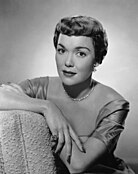The 21st Academy Awards were held on March 24, 1949, honoring the films of 1948. The ceremony was moved from the Shrine Auditorium to the Academy's own theater, primarily because the major Hollywood studios had withdrawn their financial support in order to address rumors that they had been trying to influence voters.[2] This year marked the first time a non-Hollywood production (Laurence Olivier's Hamlet) won Best Picture, and the first time an individual (Olivier) directed himself in an Oscar-winning performance.
| 21st Academy Awards | |
|---|---|
| Date | March 24, 1949 |
| Site | The Academy Theater, Hollywood, California, USA |
| Hosted by | Robert Montgomery[1] |
| Highlights | |
| Best Picture | Hamlet |
| Most awards | Hamlet (4) |
| Most nominations | Johnny Belinda (12) |
The Academy Award for Best Costume Design was introduced this year.[1] Like Best Cinematography and Best Set Decoration, it was split into Color and Black & White categories.
John Huston directed his father, Walter Huston, to the Academy Award for Best Supporting Actor for his role as Howard in The Treasure of the Sierra Madre, a unique accomplishment. The Huston family won three Oscars that evening (John won for Best Director and Best Screenplay, both for the same film). Humphrey Bogart's lack of a nomination for Best Actor has been since considered one of the Academy's greatest slights.[3][4]
Joan of Arc set a record by receiving seven nominations without being nominated for Best Picture; this stood until They Shoot Horses, Don't They? (1969) received nine nominations at the 42nd Academy Awards without one for Best Picture. Walter Wagner, producer of the film, was not pleased to see the film avoid a Best Picture nomination, and turned down a special Oscar designed to make up for this slight.[5]
Hamlet became the fifth film to win Best Picture without a screenwriting nomination; the next to do so would be The Sound of Music at the 38th Academy Awards. Jane Wyman became the first performer since the silent era to win an Oscar for a performance with no lines;[4] Johnny Belinda was the fourth film to receive nominations in all four acting categories.
I Remember Mama received four acting nominations but not one for Best Picture, tying the record set by My Man Godfrey in 1936. Two more films to date have tied this record: Othello (1965) and Doubt (2008).
Winners and nominees
Awards
Nominees were announced on February 10, 1949. Winners are listed first and highlighted in boldface.[6]
Academy Honorary Awards
- Sid Grauman "master showman, who raised the standard of exhibition of motion pictures".
- Adolph Zukor "a man who has been called the father of the feature film in America, for his services to the industry over a period of forty years".
- Walter Wanger "for distinguished service to the industry in adding to its moral stature in the world community by his production of the picture Joan of Arc".
Best Foreign Language Film
Academy Juvenile Award
Irving G. Thalberg Memorial Award
Scientific or Technical
Class II
- Victor Caccialanza, Maurice Ayers and the Paramount Studio Set Construction Department for the development and the application of "Paralite", a new lightweight plaster process for set construction
- Nick Kalten, Louis J. Witt and the Twentieth Century-Fox Studio Mechanical Effects Department for a process of preserving and flame-proofing foliage
Class III
- Marty Martin, Jack Lannon, Russell Shearman and the RKO Radio Studio Special Effects Department; A.J. Moran and the Warner Bros. Studio Electrical Department
Presenters and performers
Presenters
- Ethel Barrymore (Presenter: Best Motion Picture)
- Ann Blyth (Presenter: Best Sound Recording)
- Frank Borzage (Presenter: Best Director)
- Ronald Colman (Presenter: Best Actress)
- Wendell Corey (Presenter: Best Film Editing)
- Jeanne Crain (Presenter: Short Subject Awards)
- Arlene Dahl (Presenter: Best Art Direction)
- Glenn Ford (Presenter: Best Special Effects)
- Ava Gardner (Presenter: Documentary Awards)
- Kathryn Grayson (Presenter: Music Awards)
- Edmund Gwenn (Presenter: Best Supporting Actress)
- Jean Hersholt (Presenter: Honorary Awards)
- Celeste Holm (Presenter: Best Supporting Actor)
- Louis Jourdan (Presenter: Best Foreign Film)
- Deborah Kerr (Presenter: Writing Awards)
- George Murphy (Presenter: Scientific & Technical Awards)
- Robert Ryan (Presenter: Best Cinematography)
- Elizabeth Taylor (Presenter: Best Costume Design)
- Loretta Young (Presenter: Best Actor)
Performers
- Harry Babbitt and Gloria Wood ("The Woody Woodpecker Song")
- Doris Day ("It's Magic" from Romance on the High Seas)
- Gordon MacRae ("For Every Man There's a Woman" from Casbah)
- Jane Russell ("Buttons and Bows" from The Paleface)
- Jo Stafford ("This Is the Moment" from That Lady in Ermine)
Multiple nominations and awards
| Awards | Film |
|---|---|
| 4 | Hamlet |
| 3 | The Treasure of the Sierra Madre |
| 2 | Joan of Arc |
| The Naked City | |
| The Red Shoes |







